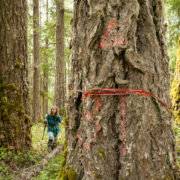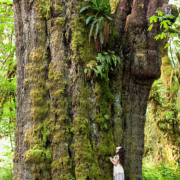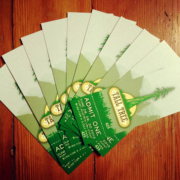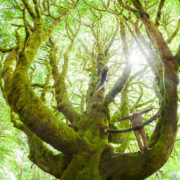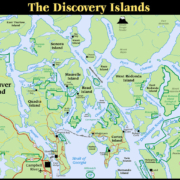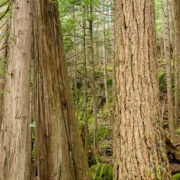Island Timberlands Moves to Log Contentious Old-Growth Forests and Deer Winter Range Intended for Protection on Vancouver Island
Island Timberlands is moving full throttle to log some of their most contentious old-growth forest lands near Port Alberni, including “Juniper Ridge”, an ungulate winter range formerly intended for protection, and Labour Day Lake, the headwaters of Cathedral Grove’s Cameron River.
See beautiful photos of the highly scenic Juniper Ridge here: https://16.52.162.165/photos-media/juniper-ridge/
Earlier this week, Island Timberlands began road construction into an ungulate winter range formerly intended for protection for black-tailed deer in an old-growth forest near Port Alberni on Vancouver Island, an area referred to by conservationists as “Juniper Ridge”. Juniper Ridge is an increasingly rare tract of old-growth forest filled with highly endangered old-growth Douglas-fir trees, sensitive ecosystems of brittle reindeer lichens growing on open rocky outcrops, and an abundance of juniper shrubs. The area, roughly 20 hectares in size, is a one hour drive from the town of Port Alberni and is located between Ash and Turnbull Lakes. This is a popular recreational area where many Alberni locals and tourists fish, camp, canoe, and hike.
“The old-growth forest and lichen-covered rocky outcrops on Juniper Ridge are endangered and sensitive ecosystems largely growing on extremely thin soils. It would take many centuries for the old-growth forest to fully recover here after logging. Unfortunately, with the trend of harvesting smaller sized trees with shorter logging rotations, these old growth Douglas- fir ecosystems will never have the chance to return,” stated Jane Morden, coordinator of the Watershed-Forest Alliance based in Port Alberni. “This forest is heavily used by wintering deer, and was intended to be preserved for this purpose. This area is also a popular recreation destination for locals and tourists going hiking, fishing and boating.”
The Watershed-Forest Alliance, with support from Alberni-Pacific Rim MLA Scott Fraser, have met with and have asked Island Timberlands to stay out of all previously planned Ungulate Winter Range and Wildlife Habitat Areas. The land was largely deregulated in 2004 due to its removal from Tree Farm Licence (TFL) 44 and planned protections were never implemented. A subsequent agreement between the former licencee and the BC government was supposed to have resulted in the protection of these lands, but has not been pursued. Instead the company has chosen to simply log these high conservation value forests. Of the original 2400 hectares of lands intended for protection, only about 900 hectares remain unlogged which amounts to just over 1% of the total 74,000 hectares removed from TFL 44.
“The BC government never implemented the planned environmental protections on these lands a few years ago, putting them in jeopardy. Now they need to do the right thing and properly protect these lands, either by purchasing them or re-regulating them and putting in place the intended protections,” stated Jane Morden, coordinator of the Watershed-Forest Alliance.
Recent logging that began in early June also threatens the old-growth subalpine forests at Labour Day Lake, not an intended Ungulate Winter Range, but a popular recreation destination not far from Port Alberni. The lake is surrounded by ancient yellow cedars and mountain hemlocks and is the headwaters of the Cameron River which flows into the famed Cathedral Grove.
The Ancient Forest Alliance is calling on the provincial government to establish a BC Park Acquisition Fund of at least $40 million per year, raising $400 million over 10 years, to purchase old-growth forests and other endangered ecosystems on private lands across the province, such as Juniper Ridge and Labour Day Lake. The fund would be similar to the park acquisition funds of various regional districts in BC which are augmented by the fundraising efforts of private citizens and land trusts.
“Island Timberlands needs to put the brakes on their plans to log any more of their forests that were formerly protected or planned for protection and other contentious old-growth forests, otherwise they’ll face increasing international markets pressure. Meanwhile Christy Clark’s BC Liberal government must step forward to protect these lands. Part of what’s needed is a BC Park Acquisition Fund, similar to those of many regional districts, to purchase endangered ecosystems on private lands for protection,” stated TJ Watt, Ancient Forest Alliance campaigner.
Island Timberlands also plans or has been logging numerous other contentious forests, including:
- The south side of Mt. Horne on the mountain above the world-famous Cathedral Grove
- McLaughlin Ridge, a prime old-growth deer winter range and important habitat for the endangered Queen Charlotte Goshawk. With trees similar in size to Cathedral grove, McLaughlin Ridge helps to protect the China Creek Watershed which is the source of drinking water for the city of Port Alberni.
- Cameron Valley Firebreak, a rare valley bottom-to-mountain top old-growth forest that the company has already logged large swaths of.
- The west side of Father and Son Lake, a popular fishing area for local Port Alberni residents.
- Pearl Lake, near Strathcona Provincial Park.
- Stillwater Bluffs near Powell River.
- Day Road Forest near Roberts Creek.
- Old-growth and mature forests on Cortes Island.
The Ancient Forest Alliance and local conservationists are calling for the protection of old-growth forests, sustainable logging in second-growth forests, and an end to the export of raw logs to foreign mills in order to ensure a guaranteed log supply for BC mills.
BACKGROUNDER:
In 2004 the BC Liberal government removed 88,000 hectares of Weyerhaeuser’s forest lands, now owned by Island Timberlands, from their Tree Farm Licences (TFL’s), thus removing many environmental protections and exempting the area from many other intended protections. This includes designated protections such as Riparian Management Reserves, the prohibition against conversion of forest lands to real estate developments, and provincial restrictions on raw log exports on those lands; and planned protections such as Old-Growth Management Areas, Wildlife Habitat Areas, Visual Quality Objectives, as well as Ungulate Winter Ranges (UWR’s) at Juniper Ridge, McLaughlin Ridge, Cameron Valley Firebreak, forests by Father and Son Lake, and south Mt. Horne by Cathedral Grove.
The original logging rights on public (Crown) lands on Vancouver Island were granted to logging companies for free earlier last century on condition that the companies allowed their adjacent private forest lands to be placed into regulatory designations known as Tree Farm Licences (TFL’s), in order to control the rate of cut, ensure their logs went to local mills, and to ensure environmental standards on those private lands.
In recent times the companies (Weyerhaeuser in 2004 and Western Forest Products in 2007) greatly benefitted from the removal of their private lands from their TFL’s as it allowed them to log previously protected forests, to export raw logs, and to sell-off forest lands to developers – but meanwhile were still allowed to retain their Crown land logging rights (despite no longer upholding the conditions of the original agreement on their private lands).
This failure to uphold the original agreement is considered by many to be a breach of the public interest. Weyerhaeuser has since moved off the coast, with the company’s former private lands now owned by Island Timberlands and its Crown land logging rights held by Western Forest Products.

